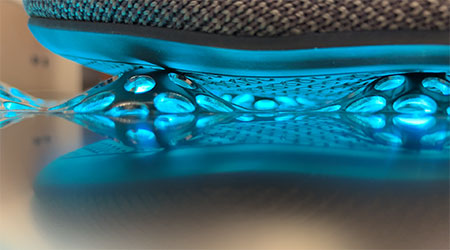Shoes and even shoe covers in hospital and healthcare settings can easily cross-contaminate surfaces and spread viruses, including COVID-19. Studies have shown contamination after just five minutes of walking hallways or spending time in the bathroom. Shoes and socks then spread viruses to other surfaces. For example, if a patient gets out of bed, uses the bathroom and then returns to bed, bacteria from the floor will migrate to the bed to be easily touched by the patient, doctors and nurses.
Floors and shoes are typically considered low risk areas and while routinely cleaning, they are not disinfected. But this could be a dangerous error.
A recent interview with Kevin W. Garey, PharmD, MS, FASHP, Professor and Chair of the Department of Pharmacy Practice and Translational Research at University of Houston College of Pharmacy, discusses the benefit of using UVC light to disinfect shoes to prevent virus spread.
Question: What role do you see for UVC light in infection prevention on shoes? What protocols do you recommend following?
Answer from Kevin W. Garey: Because we know that floors are often contaminated and that shoe bottoms carry an abundance of unwanted pathogens, we need to start addressing the issue of recontamination. We need to identify the places where we want to avoid recontamination and start to target and eradicate organisms on shoe bottoms in those areas.
Using UVC light to solve this problem is a particularly strong method for keeping these areas sterile (i.e. surgical suites, ICU units, pharmacies, etc.). Our research has found that a UVC device targeting shoe soles can decrease subsequent environmental bioburden and patient colonization.
Question: What are the benefits of UV-C light over other sanitization methods you have seen employed?
Answer: The nice thing about UVC is that it’s difficult for organisms to become resistant to it, as opposed to antibiotics and antibacterial cleaners. For shoes, specifically, there really isn’t any other suitable method. You can use booties, but if you walk on a contaminated floor, you’re still going to spread organisms with each step. It’s also been shown that the bottoms of shoes contained inside the booties can contaminate the booties themselves. So, there really isn’t a good alternative, which makes UVC shoe sanitizer technology so novel and interesting.
Question: How well do conventional UVC room units work with pathogens found on floors? Wouldn’t that be sufficient to prevent spread?
Answer: Whatever you can do to clean the floors, do it. However, after you’ve done a deep clean of the floor, you don’t want to have a dirty shoe bottom ruin the work you just did. So, UVC room units and UVC shoe sanitizers should work together as a synergistic one-two punch to ensure that floors are clean and that they do not get recontaminated.

 Building Sustainable Healthcare for an Aging Population
Building Sustainable Healthcare for an Aging Population Froedtert ThedaCare Announces Opening of ThedaCare Medical Center-Oshkosh
Froedtert ThedaCare Announces Opening of ThedaCare Medical Center-Oshkosh Touchmark Acquires The Hacienda at Georgetown Senior Living Facility
Touchmark Acquires The Hacienda at Georgetown Senior Living Facility Contaminants Under Foot: A Closer Look at Patient Room Floors
Contaminants Under Foot: A Closer Look at Patient Room Floors Power Outages Largely Driven by Extreme Weather Events
Power Outages Largely Driven by Extreme Weather Events